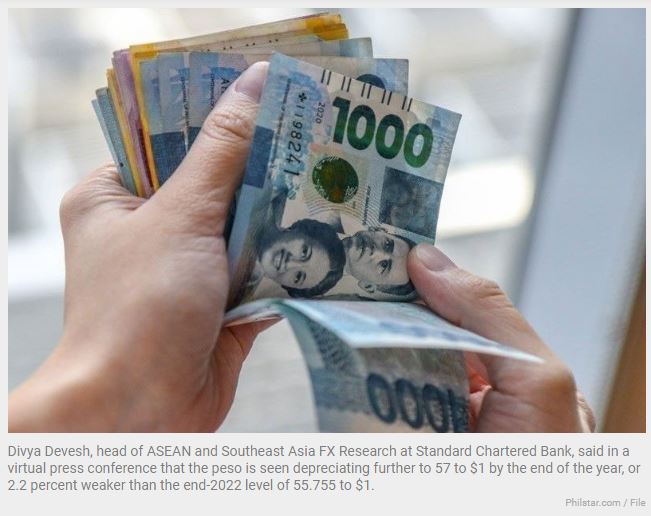Philippines: Peso seen weakening for 3rd straight year
MANILA, Philippines — The peso is likely to depreciate further for the third straight year in 2023, hitting the 57 to a dollar level anew, according to two global financial institutions.
Divya Devesh, head of ASEAN and Southeast Asia FX Research at Standard Chartered Bank, said in a virtual press conference that the peso is seen depreciating further to 57 to $1 by the end of the year, or 2.2 percent weaker than the end-2022 level of 55.755 to $1.
“For 2023, our forecast for dollar-peso is at 57,” Devesh said.
The peso depreciated for the second straight year to 50.999 in 2021 and further to 55.755 in 2022 after appreciating to 48.023 in 2020 from 50.635 in 2019.
Due to the aggressive rate hikes delivered by the US Federal Reserve to tame inflation last year, the local currency slumped by as much as 15.7 percent to hit a new all-time low of 59 to $1 in October.
With the Bangko Sentral ng Pilipinas (BSP) matching the aggressive rate hikes delivered by the US Fed point by point to maintain a healthy interest rate differential, the peso has returned to the 54 to $1 handle.
Likewise, Fitch Solutions said it expects the peso to weaken to 56.50 to $1 this year before strengthening to 54.50 to $1 next year.
“Over 2023, we forecast the Philippine peso to depreciate against the dollar to 56.5 in 2023, from 54.5 in 2022. For the Philippines, which remains heavily reliant on imports to meet local demand, this will provide further headwinds to consumers as imports will become costlier,” Fitch Solutions said.
Standard Chartered’s Devesh said the Philippines is expected to book a wider current account deficit this year amid the surge in imports that outpace the growth in exports.
“I think that the sort of main underlying factor which we think will lead to higher dollar-peso this year is really the external balance story. Philippines’ current account deficit in 2023 is still projected to be wide, both by our forecasts and by the central bank’s forecasts,” Devesh said.
He said the wider shortfall is a function of softening of exports and oil prices remaining relatively elevated.
Devesh added that the Balance of Payments (BOP) position would continue to remain challenging for the Philippines.
“Even the central bank sort of expects another year of BOP deficit in 2023, following 2022, which was also an overall BOP deficit year. So I think you will still have an excellent balance backdrop, which is going to be broadly negative for the peso,” Devesh said.
“We have seen a sharp rally in the peso since October. And at these kind of levels, its sort of quite difficult that the dollar-peso value is quite high or the peso is undervalued,” Devesh said.
Standard Chartered Bank economist for Asia Jonathan Koh said the country’s current account deficit is seen easing to four percent of gross domestic product (GDP) in 2023 and 2.4 percent of GDP in 2024 from a high of 6.4 percent of GDP last year.
Koh likewise expects the budget deficit to decline to 6.1 percent of GDP this year and 4.9 percent of GDP next year, from 7.5 percent of GDP in 2022.
The British banking giant sees the GDP growth slowing down to 5.3 percent this year from 7.6 percent last year before accelerating to six percent next year.
Koh said the BSP Monetary Board is seen delivering two 25-basis point hikes in the first half of the year, bringing the benchmark rate to six percent from the current 5.50 percent, before slashing it by 50 basis points in the fourth quarter of the year back to 5.50 percent and by another 100 basis points to 4.50 percent next year.
In a commentary titled “Philippines Consumer Outlook,” Fitch Solutions said it expects the country’s GDP growth to slow down to 5.9 percent this year from 7.6 percent last year due to elevated energy prices and tighter monetary conditions.
The research arm of the Fitch Group sees inflation remaining elevated at 5.4 percent this year, well above the BSP’s two to four percent target range and would continue to negatively impact the prospects for Filipino consumers.
“We forecast real household spending to grow by 5.5 percent year-on-year n 2023. This is down from the 8.2 percent growth forecast in 2022. Consumer confidence has increased since its all-time low reported in Q220. However, since then it has remained negative. Retail sales increases have remained sluggish since the pandemic but are starting to show signs of improvement,” it added.
Source: https://www.philstar.com/business/2023/02/02/2241842/peso-seen-weakening-3rd-straight-year-


 Thailand
Thailand




